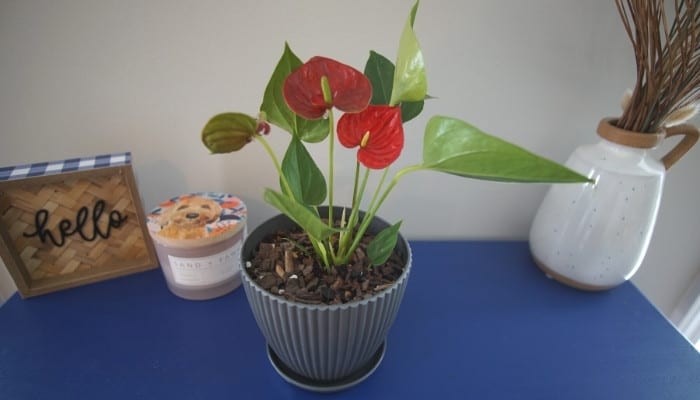The lush, verdant leaves and scarlet, heart-shaped blooms of the Anthurium plant imbue your living space with a touch of paradise.
You’ll be pleased to know that this tropical stunner, also known as the flamingo flower, isn’t overly hard to look after either.
How do you care for Anthurium? In order to thrive and bloom successfully, Anthuriums require a porous, slightly acidic soil, bright but indirect light, temperatures between 60 and 90°F, weekly watering, fertilization every 3-4 months, and humidity levels around 80%. Direct sunlight and heavy shade should be avoided.
Caring for Anthurium: Basic Guidelines
Basic care will keep this plant ticking along, but regular effort can reward you with beautiful berry-bearing blooms throughout the year!
From a breakdown of their environmental needs to repotting advice, FAQs, and more, we’ll cover how to make your Anthurium truly happy.
Complete Care Guide for Anthurium
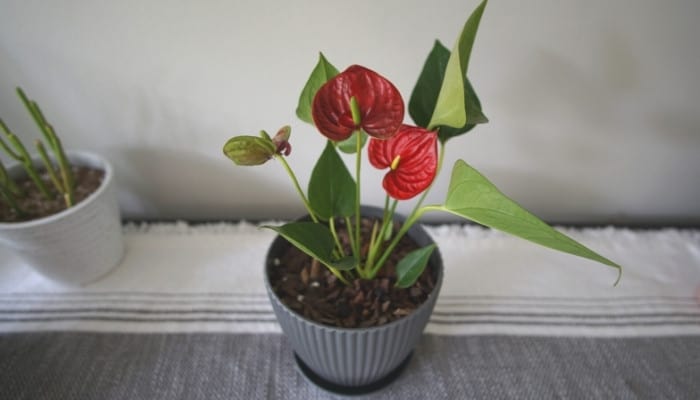
The Anthurium andraeanum species was originally discovered by French botanist and architect Édouard François André during a mission in the Columbian rainforest in 1876.
He later exported it to Belgium where it soon became a popular landscape and indoor plant.
As well as being celebrated for its flowers, Anthurium plants have also been heralded for their eco-friendly status, with NASA listing it in a 1989 Clean Air Study for its effective removal of ammonia and formaldehyde from the air.
Anthurium at a Glance
- Plant Type: Herbaceous evergreen
- Scientific Name: Anthurium
- Average Height: 1-2 feet
- Average Width: 2-3 feet
- Growth Rate: Slow
- Produces Flowers: Yes
- Common Pests: Scales, mealy bugs
- Life Expectancy: 5-10 years, longer if propagated
- Difficulty of Care: Easy
What To Do When You First Get Your Anthurium
- See if it needs watering – Feel the top few inches of soil with your finger – if it feels moist, perfect! – this is its ideal condition, so check back the next day. If it feels dry, give it a drink, and check that the water drains well through the pot holes.
- Find the best spot for it– Anthurium plants’ beautiful flowers won’t bloom in the shade or in direct sunlight, so place it where it will get indirect light – the corner of a bright room with a curtained window is ideal (see Lighting Needs and Location below).
- Check for any pests – Fortunately, Anthurium plants aren’t overly susceptible to bugs, but detecting any insects or signs of their sticky residue is best done sooner rather than later (see Common Pests below).
Ideal Soil for Anthurium
Anthurium plants favor slightly acidic soil and need a porous medium for any hopes of blooming.
Blogger and author of Houseplants Made Easy Andrew Courtney recommends mixing:
“equal parts peat-based soil, perlite (lightweight granular rocks), and pine bark as this creates a breathable soil blend similar to the moss and leaf litter in their native habitat.”
Anthurium Water Requirements
Water your Anthurium once weekly throughout the growing season (March-September) and less frequently – around once every two weeks – during its dormant winter period.
The humidity, temperature, and light conditions of your home environment will determine its watering frequency, so feel the soil every other day to establish a good pattern.
Anthurium Lighting Needs
These plants thrive in bright but indirect light to encourage healthy flower growth without scorching the leaves.
Placing it in a west- or south-facing window during spring and summer will be ideal.
It will tolerate lower lighting conditions over winter, though too little light can cease flower production.
This healing box may help a plant that struggles in the winter.
Ideal Temperature Range for Anthurium
Anthurium plants will generally tolerate a range between 60-90°F (15-32°C) and will be happiest in consistent temperatures of 86°F during the day.
Though they have a hardy nature, don’t let temperatures drop to 50°F and below as blooming will cease and death won’t be far behind.
Ideal Humidity Level for Anthurium
At least 80% humidity will help this flowering plant thrive.
As this can be hard to achieve in many home climates, plant author Andrew Courtney advises “misting with room temperature water every couple of days and using a humidifier or humidity tray.”
Best Location for Anthurium
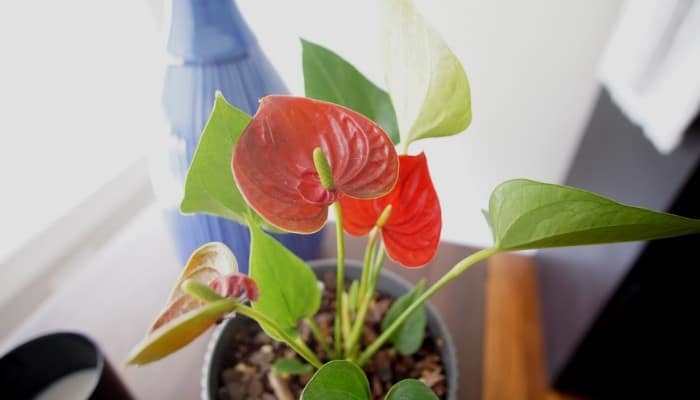
Inside or in the vicinity of your bathroom is a good choice due to their high humidity needs.
Just make sure it is placed in a spot of suitably indirect sunlight and won’t be at risk of getting splashed as overly moist soil and foliage can lead to bacterial blight down the line.
Anthurium Growth Habits
Anthurium plants grow upright in a spherical, bushy form with symmetrical foliage.
Fertilization Type & Schedule for Anthurium
A water-soluble fertilizer will be best and will only need to be applied once every 3-4 months during March-September to promote flowering.
Heather Rhoades at Gardening Know How advises: “diluting liquid fertilizer to a 1/4 strength solution and use a variety with a high phosphorus number (the middle digit) to get the best blooms.”
Signs of Nutrient Deficiency
Anthurium plants that begin to have dull foliage (losing their leaves’ natural glossy quality), yellow or brown coloring, and wilting can all be signs that it is lacking in nutrients.
This can be caused by unbalanced watering, which leads to soggy or starved roots. Ensuring humidity levels and other environmental conditions are met can help prevent lasting damage.
Pruning Anthurium
This plant needs only occasional pruning to remove damaged or dead flowers and leaves.
Always do so with pruning shears that have first been disinfected with rubbing alcohol to keep diseases at bay.
Does Anthurium Produce Flowers?
Anthurium plants sporadically produce bold blooms that typically come in red or hot pink.
The flowers are actually made up of spathes or bracts (modified leaves) that resemble large petals.
Growing from the center is a yellow finger-like spike known as the spadix, which is from where red berries grow with exceptional care.
Is Anthurium Toxic?
Anthurium is high in insoluble calcium oxalates which, if ingested, can cause oral irritation, swelling, and breathing difficulties in pets, according to the ASPCA (The American Society for the Prevention of Cruelty to Animals).
The plant sap may also cause skin irritation in people with allergies.
Anthurium Propagation
Anthurium plants can be propagated (divided into new ‘offspring’ plants from the parent plant) via stem cuttings or root division.
Stem cutting is a great option when your plant becomes too leggy, but as root division is the most beginner-friendly option, we’ll detail how this method works below:
1. Remove Plant From Its Container & Break the Soil Loose
Slide the base of the plant out of its container pot and begin carefully breaking the soil apart by hand.
You can submerge the soil in water or use a clean knife to break up the base if it is particularly tough.
2. Divide the Main Root Structure Into New Sections
With the excess soil removed, take a sharp, clean knife and divide the crown root system into sections of two or more.
Ensure each new section has at least one leaf and healthy-looking roots (they should be cream colored and firm, not black and mushy).
3. Plant the Sections Into New Pots & Water Each One Thoroughly
Prepare each new pot with 1/3 of your ideal potting soil medium (it helps to do this beforehand) and place each new root section into the center of its pot to stabilize it before pouring the remaining soil on top.
Water them well, checking that each pot drains well, and find a suitable spot for your new baby Anthuriums!
Repotting Anthurium
Anthurium plants will need repotting periodically as they outgrow their current pot and will benefit from being repotted in fresh soil for long-lasting health.
When To Repot Anthurium
You should aim to repot every 2-3 years, as the roots can begin to crowd the pot in this time and cause the plant to become rootbound.
As well as becoming rootbound, your Anthurium can start to suffer if it has sat in the same soil for years and is no longer draining or retaining moisture as effectively.
Signs That It’s Time To Repot
- Roots circling the soil, appearing beneath the drainage holes
- Water runs right through pot holes (no moisture retention)
- Wilted foliage, slow/stunted growth
How To Repot Anthurium
1. Prepare a New Pot 2 Inches Larger Than the Current One
Make sure you have a new pot that is at least 2 inches larger in diameter than your existing pot, and clean it thoroughly before filling it a 1/3 of the way with the ideal soil medium.
This can be a good opportunity to add in more organic material, like perlite and pine bark, to improve moisture retention and drainage.
2. Remove the Plant From Its Existing Pot & Check the Roots
Snip off any extended roots beneath the pot with clean pruning shears before sliding your Anthurium out of its old pot, and gently remove the old soil by hand.
Once you can see the root structure, check to see they are a healthy color and feel firm (remove damaged areas as needed with a sharp, sterile knife).
3. Re-plant Your Anthurium Into Its New Container Pot
With only healthy roots remaining, gently place your Anthurium plant into its brand new pot at roughly the height it was growing originally, and add the remaining 2/3 of soil mix.
Water it thoroughly and inspect the drainage quality before setting it back in its ideal location.
Don’t be discouraged if growth is a little slow in the days or even weeks after repotting as being rehomed can stress your Anthurium at first.
Anthurium Common Problems & Solutions That Work
Anthurium Common Pests
While their thick leaves make them fairly resistant to biting pests, Anthurium plants can still attract sap-sucking critters.
Here are two common menaces and how to deal with them:
Scales
- Signs of Trouble – Small brown rice-shaped insects, sticky honeydew residue on foliage.
- Solution – Dab individual scales with a cotton swab dipped in rubbing alcohol to dissolve them or soften them with soapy water spray before remove them with a damp cloth.
- Prevention – Spray foliage with neem oil occasionally (a natural pesticide). I’ve seen great results with this organic neem.
Mealybugs
- Signs of Trouble – Cotton-wool-like woodlice on leaves.
- Solution – Spray areas with soapy water or an organic insecticidal soap.
- Prevention – Reduce watering frequency, and keep plant room well ventilated as they love wet areas. Remove groups by hand or with a stick.
Anthurium Common Diseases
A poor soil medium and improper conditions can put this plant at risk of developing foliage and root diseases.
Here are two of the more common culprits and how to deal with them:
Bacterial Blight
- Signs of Trouble – Yellowish, water-soaked spots on leaves.
- Solution – Prune back affected foliage, and let soil dry fully before next watering.
- Prevention – Review watering and misting regimen, and ensure humidity and temperature levels are correct.
Root Rot
- Signs of Trouble – Dark mushy roots, severely wilted foliage.
- Solution – Trim off diseased root sections with clean pruning shears, and repot in fresh soil.
- Prevention – Reduce watering frequency, and ensure soil medium drains well.
Other Common Problems
As these tropical plants require a specific environment to thrive, it’s only natural for foliage to look less than its best from time to time.
Take quick action if you spot these common issues to rescue your Anthurium.
Faded Leaves
- Signs of Trouble – Bleached center of leaf, brown tips.
- Solution – Prune affected foliage, and move plant to an area of ideal light.
- Prevention – Keep the plant out of direct sunlight, consider installing sheer curtains or fabric shades in the current window.
Yellow Leaves
- Signs of Trouble – Mild to excessive yellowing of entire leaf.
- Solution – Trim mild discoloration in line with leaf shape or prune back entire leaf for excessive damage. Reduce watering frequency.
- Prevention – Allow soil to dry out in between watering, and check your current soil mix drains well.
Anthurium Common Questions
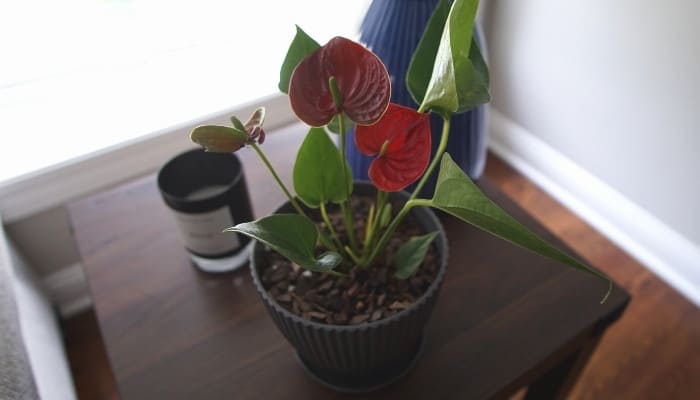
Can I Put My Anthurium Outside?
Anthurium plants can go outside if placed in half-shade under a tree, canopy, or awning-type garden feature.
Growing your Anthurium outdoors can give it the boost it needs to encourage flowering – just be sure to bring it back indoors if temperatures exceed 90°F during the day or dip below 50°F at night.
How Many Types of Anthuriums Are There?
There are over 1,000 Anthurium species within the Araceae family, and almost every flowering plant variety has been cultivated from the original Anthurium andraeanum species.
These Anthurium varieties exhibit various sizes, colors, textures, and veination, with many grown for their decorative foliage instead of flowers.
What Colors Do Anthuriums Come In?
Anthurium flowering plants that have been bred from Anthurium andraeanum feature spathes (flowers) in various shades of red, pink, purple, white, green, orange, and cream.
Many feature color combos such as the stunning Tulip Anthurium with a violet spadix surrounded by candy pink petals.
What Are the Most Popular Anthuriums?
Some of the most popular Anthurium varieties include:
- Anthurium scherzerianum – featuring a red corkscrew-shaped spadix like a pig’s tail.
- Anthurium crystallinum – characterized by large velvety spade-shaped leaves with a shimmering white vein pattern.
- Anthurium watermaliense – noted for its elegant deep-purple almost black flowers and spadix.
What Is the Largest Anthurium?
The velvety, patterned foliage of the Anthurium regale can reach heights of 5-8 feet.
A close contender is Anthurium faustomirandae or ‘Faustino’s Giant’, a relatively new variety exclusive to Mexico with broad matte-green foliage that can reach a height and width of 4 feet.
What Is the Rarest Anthurium?
Anthurium cutucuense is “as rare and unique as a plant can be” according to plant author Andrew Courtney, “combining categories of narrow foliage, bubbled texture, pendant growth habit, and finger-like shape.”
This variety is native to the mountainous cloud forests of Ecuador and is nearing extinction.
How Do You Identify Anthurium?
While there are variations, Anthurium plants commonly have heart-shaped leaves that are either flat or cupped.
Smaller varieties have no flowers, but in the case of Anthurium andraeanum, these have waxy red spathes with yellow spadices and glossy, dark-green oblong leaves that droop slightly.
Why Do Anthurium Flowers Turn Green?
Flowers will naturally fade in color with age, beginning with green streaks before turning green altogether.
Premature color loss on the other hand can be due to the greenhouse practice of retailers who feed their cultivars hormones to boost color hue or force them to bloom at improper times.
Why Are My Anthurium Flowers Small?
Your Anthurium flowers will be small if environmental conditions are far from ideal – too much sunlight exposure is typically the cause of small blooms.
If this isn’t the case, review your care regimen to see if you are overwatering the soil, under-fertilizing, or failing to maintain humidity levels.
Can You Water Anthurium With Ice Cubes?
Renata Goossen of the plant company Just Add Ice Orchids advocates “watering your Anthurium with just six ice cubes once a week to avoid over-watering.”
Watering with ice-cold water can shock plants, but by placing six standard-sized ice cubes on top of the soil to melt gradually, the soil will be taking in room temperature water.
Do Anthuriums Like To Be Misted?
Anthurium plants respond well to misting several times a week or daily depending on whether or not you have the help of a humidifier to reach optimal levels.
Regular misting with room temperature water can help the leaves keep their glossy sheen.
Why Is My Anthurium Leggy?
Anthurium plants appear leggy if they are overfed right at the beginning of their growing season as the nitrogen content in houseplant fertilizer causes a sudden growth spurt, creating overly long, floppy stems.
Repotting with new, short stem cuttings can help fix a leggy plant.
3 Key Tips for Success With Anthurium
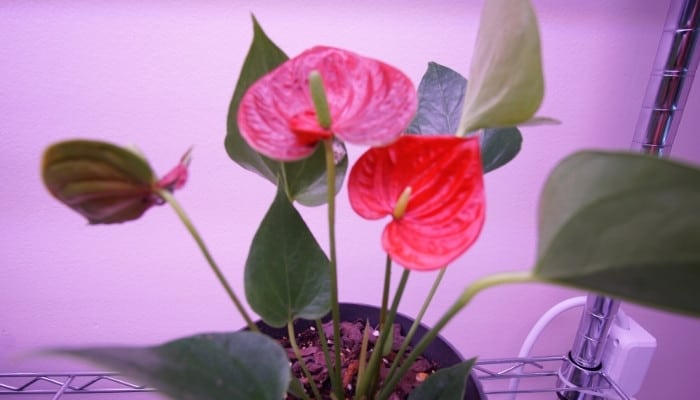
1. Provide It With the Best Conditions To Bloom
Flowering is very unlikely if the basic growing conditions are neglected.
Above all else, light levels need to be just right as too little will produce tiny blooms and sun-scorched plants won’t stand a chance.
On top of this, make sure your soil mix contains organic material such as perlite and bark to encourage draining and prevent saturated roots.
2. Flush Out Fertilizer Buildup for Super Healthy Soil
Though this plant won’t be taking in as much fertilizer compared to other plants, fertilizer use will still leave salt buildup in the soil, which can lead to root and foliage damage in the long run.
Show it some TLC by running your plant under lukewarm water for several minutes every 4-6 months to flush out these impurities.
3. Find Your Anthurium’s Watering Sweet Spot
While weekly watering is the recommended schedule, your plant may have its own personal watering needs based on factors like lighting exposure, humidity levels, and how well its soil retains moisture.
So check in with your Anthurium every other day to see that it has dried out before the next watering – use a watering calendar to help you keep track!
Conclusion
To summarize, Anthurium plants are relatively easy to care for, and their tropical head-turning qualities needn’t intimidate beginners if the fundamental care guidelines are followed.
Their vibrant blooms can be enjoyed year after year when you maintain their preferred environment, take care of pests, and prevent foliage blight with careful watering.
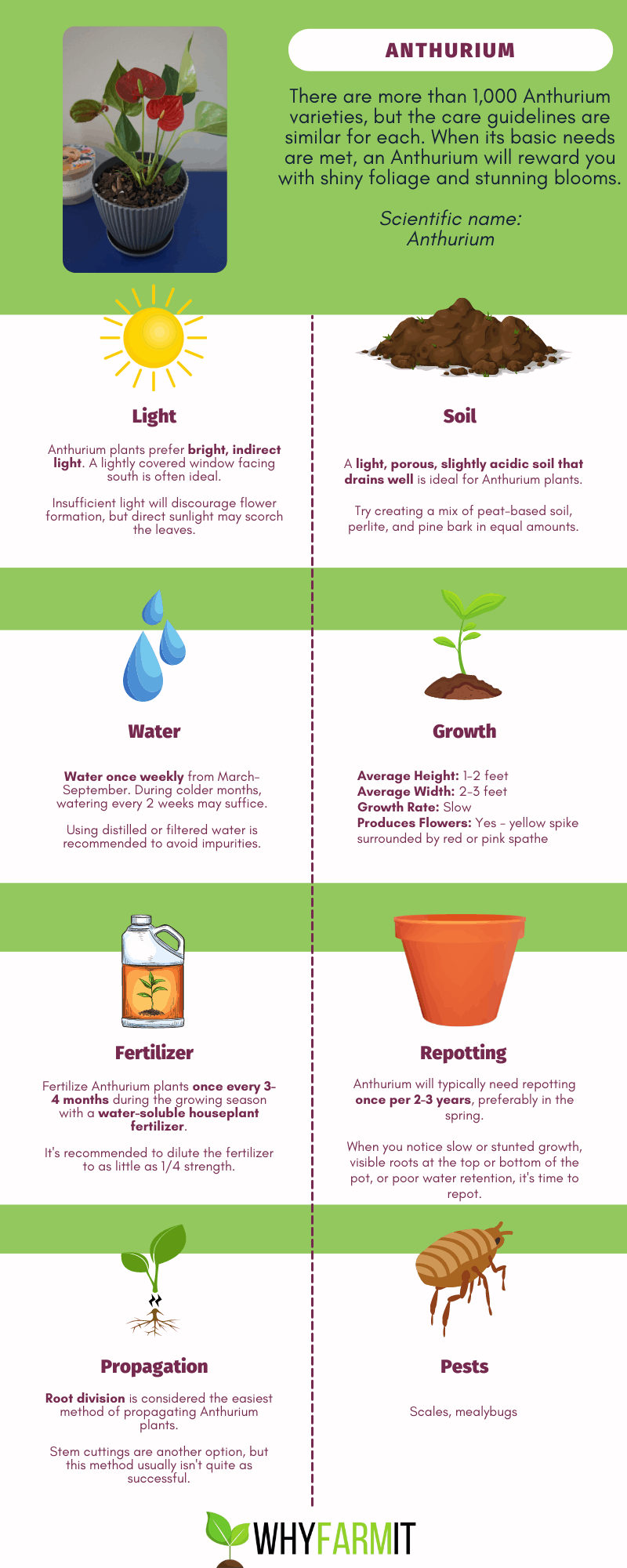
Sources:
https://ntrs.nasa.gov/citations/19930073077
https://www.jaycjayc.com/propagate-anthuriums-division/#.YQlTmfnTXIU
https://www.southernliving.com/garden/indoors/water-houseplants-ice-cubes
https://www.gardeningknowhow.com/houseplants/anthurium/repotting-anthuriums.htm
https://leafyplace.com/anthurium-types/
https://www.gardeningknowhow.com/houseplants/anthurium/anthurium-care.htm
https://smartgardenguide.com/anthurium-care/
https://www.kalliergeia.com/en/anthurium-andraeanum-flamingo-flower-the-plant-uses/
http://anthuriumhi.com/tag/anthurium-cultivars/
https://thehealthyhouseplant.com/leggy-anthurium-heres-how-to-fix-it/
https://thepracticalplanter.com/anthurium-care/
http://www.flowerspicture.org/anthurium-andraeanum-flower-varieties.html

